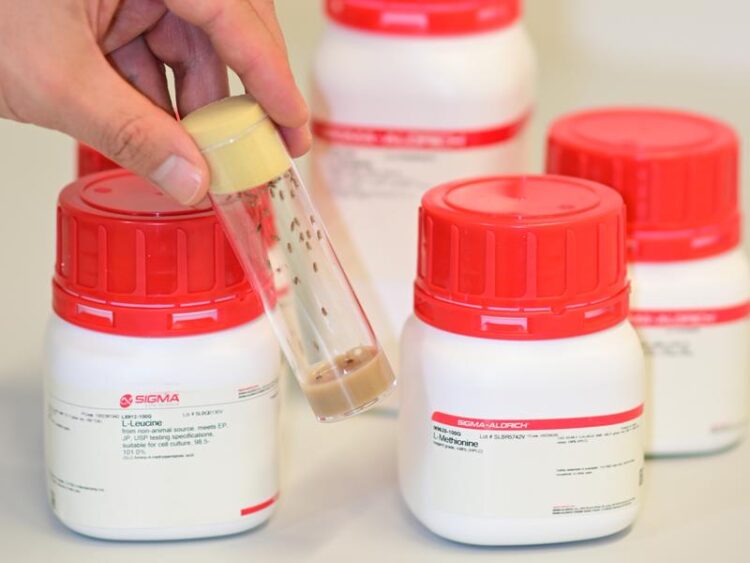Positive effector behind reduced food intake identified

Fruit flies in a vial in front of amino acids
Sebastian Grönke and Yu-Xuan Lu
Reduced food intake, known as dietary restriction, leads to a longer lifespan in many animals and can improve health in humans. The molecular mechanisms underlying the positive effects of dietary restriction are still unclear. Researchers from the Max Planck Institute for Biology of Ageing have now found one possible explanation in fruit flies: they identified a protein named Sestrin that mediates the beneficial effects of dietary restriction. By increasing the amount of Sestrin in flies, researchers were able to extend their lifespan and at the same time these flies were protected against the lifespan-shortening effects of a protein-rich diet.
The Sestrin protein makes fruit flies live longer
The health benefits of dietary restriction have long been known. Recently, it has become clear that restriction of certain food components, especially proteins and their individual building blocks, the amino acids, is more important for the organism’s response to dietary restriction than general calorie reduction. On the molecular level, one particular well-known signalling pathway, named TOR pathway, is important for longevity.
Sestrin senses amino acids and is a potential anti-ageing factor
“We wanted to know which factor is responsible for measuring nutrients in the cell, especially amino acids, and how this factor affects the TOR pathway”, explains Jiongming Lu, researcher in the department of Linda Partridge at the Max Planck Institute for Biology of Ageing. “We focused on a protein called Sestrin, which was suggested to sense amino acids. However, no one has ever demonstrated amino acid sensing function of Sestrin in a living being.” Therefore, Lu and his colleagues focused on the role of Sestrin in the model organism Drosophila melanogaster, commonly known as fruit fly.
“Our results in flies revealed Sestrin as a novel potential anti-ageing factor”, says Linda Partridge, head of the research team. “We could show that the Sestrin protein binds certain amino acids. When we inhibited this binding, the TOR signalling pathway in the flies was less active and the flies lived longer”, adds Lu. “Flies with a mutated Sestrin protein unable to bind amino acids showed improved health in the presence of a protein-rich diet.”
Particularly interesting: If the researchers increased the amount of Sestrin protein in stem cells located in the fly gut, these flies lived about 10% longer than control flies. In addition, the increased Sestrin amounts only in the gut stem cells also protected against the negative effect of a protein-rich diet.
Lu continues: “We are curious whether the function of Sestrin in humans is similar as in flies. Experiments with mice already showed that Sestrin is required for the beneficial effects of exercise on the health of the animal. A drug that increases the activity of the Sestrin protein might therefore be in future a novel approach to slow down the ageing process.
Wissenschaftliche Ansprechpartner:
Corresponding author: Prof. Dr. Linda Partridge
Max Planck Institute for Biology of Aging, Cologne
Tel.: +49 (0)221 379 70 600
E-mail: linda.partridge@age.mpg.de
Press and public relations: Kai Fiedler
Tel.: +49 (0)221 379 70 307
E-mail: kai.fiedler@age.mpg.de
Originalpublikation:
Jiongming Lu, Ulrike Temp, Andrea Müller-Hartmann, Jacqueline Esser, Sebastian Grönke and Linda Partridge.
Sestrin is a key regulator of stem cell function and lifespan in response to dietary amino acids.
Nature Aging, 2020
https://www.nature.com/articles/s43587-020-00001-7
Media Contact
All latest news from the category: Life Sciences and Chemistry
Articles and reports from the Life Sciences and chemistry area deal with applied and basic research into modern biology, chemistry and human medicine.
Valuable information can be found on a range of life sciences fields including bacteriology, biochemistry, bionics, bioinformatics, biophysics, biotechnology, genetics, geobotany, human biology, marine biology, microbiology, molecular biology, cellular biology, zoology, bioinorganic chemistry, microchemistry and environmental chemistry.
Newest articles

Magnetic Memory Unlocked with Energy-Efficient MRAM
Researchers from Osaka University introduced an innovative technology to lower power consumption for modern memory devices. Stepping up the Memory Game: Overcoming the Limitations of Traditional RAM Osaka, Japan –…

Next-Level System Security: Smarter Access Control for Organizations
Cutting-Edge Framework for Enhancing System Security Researchers at the University of Electro-Communications have developed a groundbreaking framework for improving system security by analyzing business process logs. This framework focuses on…

How Microbial Life Shapes Lime Formation in the Deep Ocean
Microorganisms are everywhere and have been influencing the Earth’s environment for over 3.5 billion years. Researchers from Germany, Austria and Taiwan have now deciphered the role they play in the…



